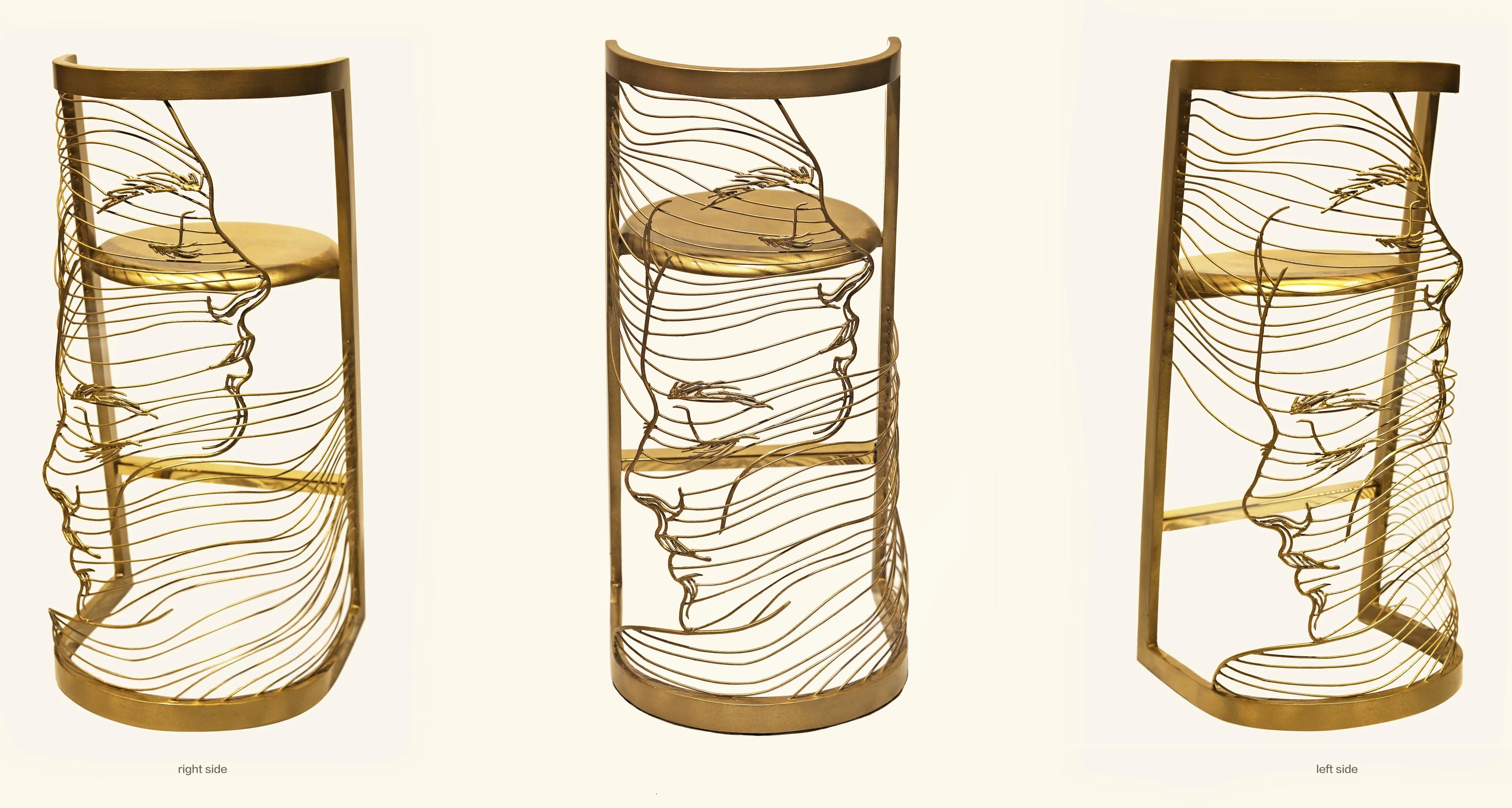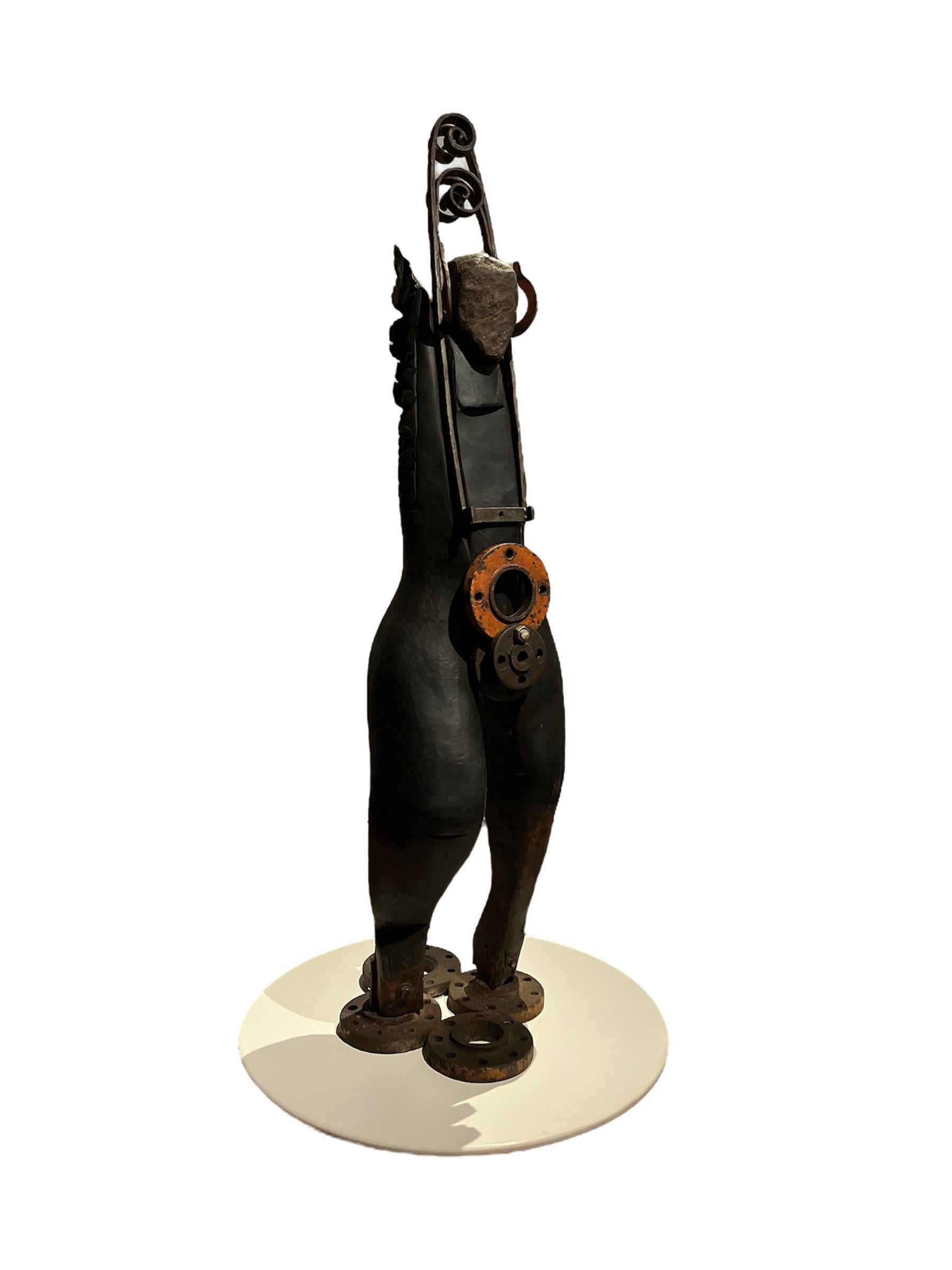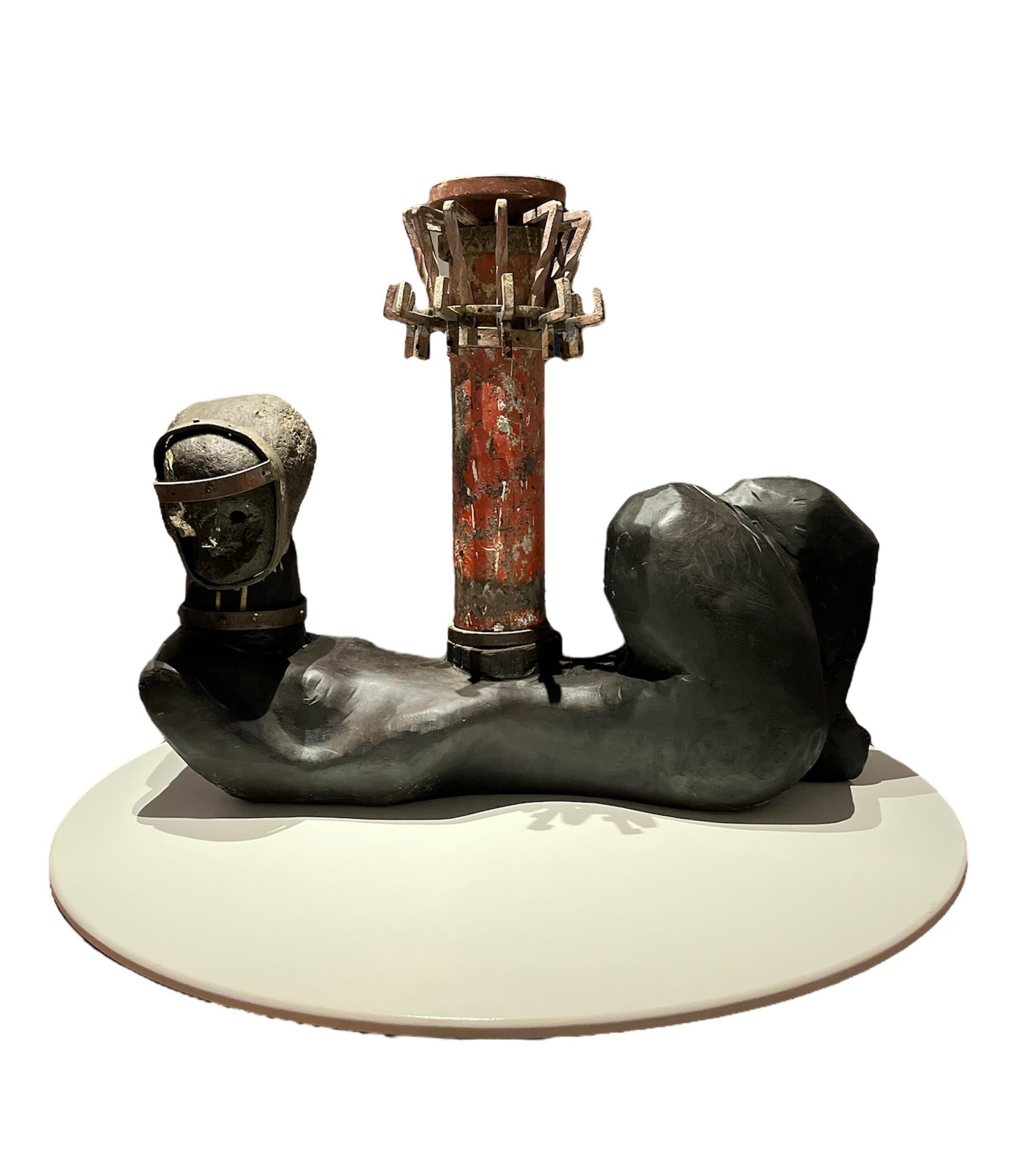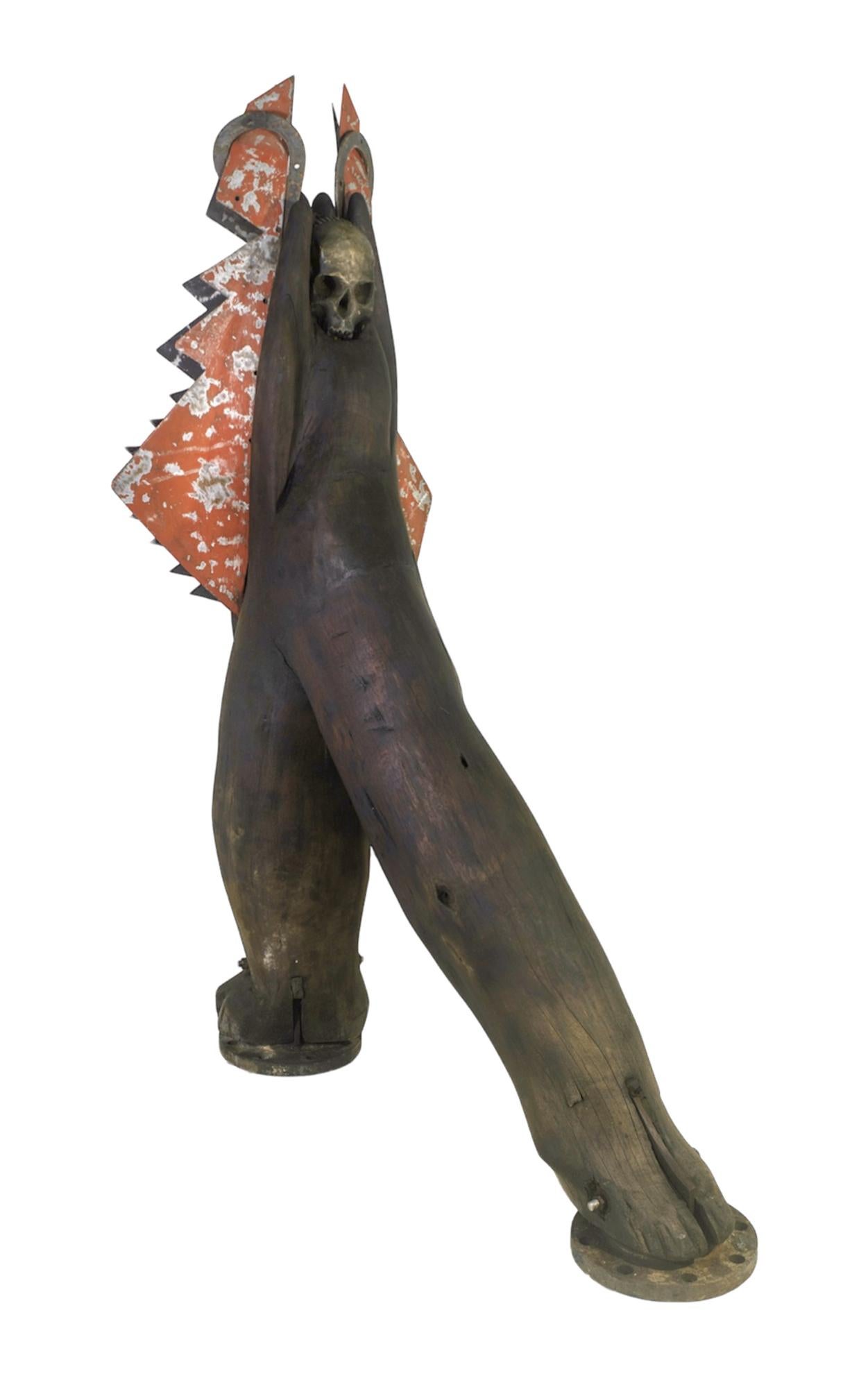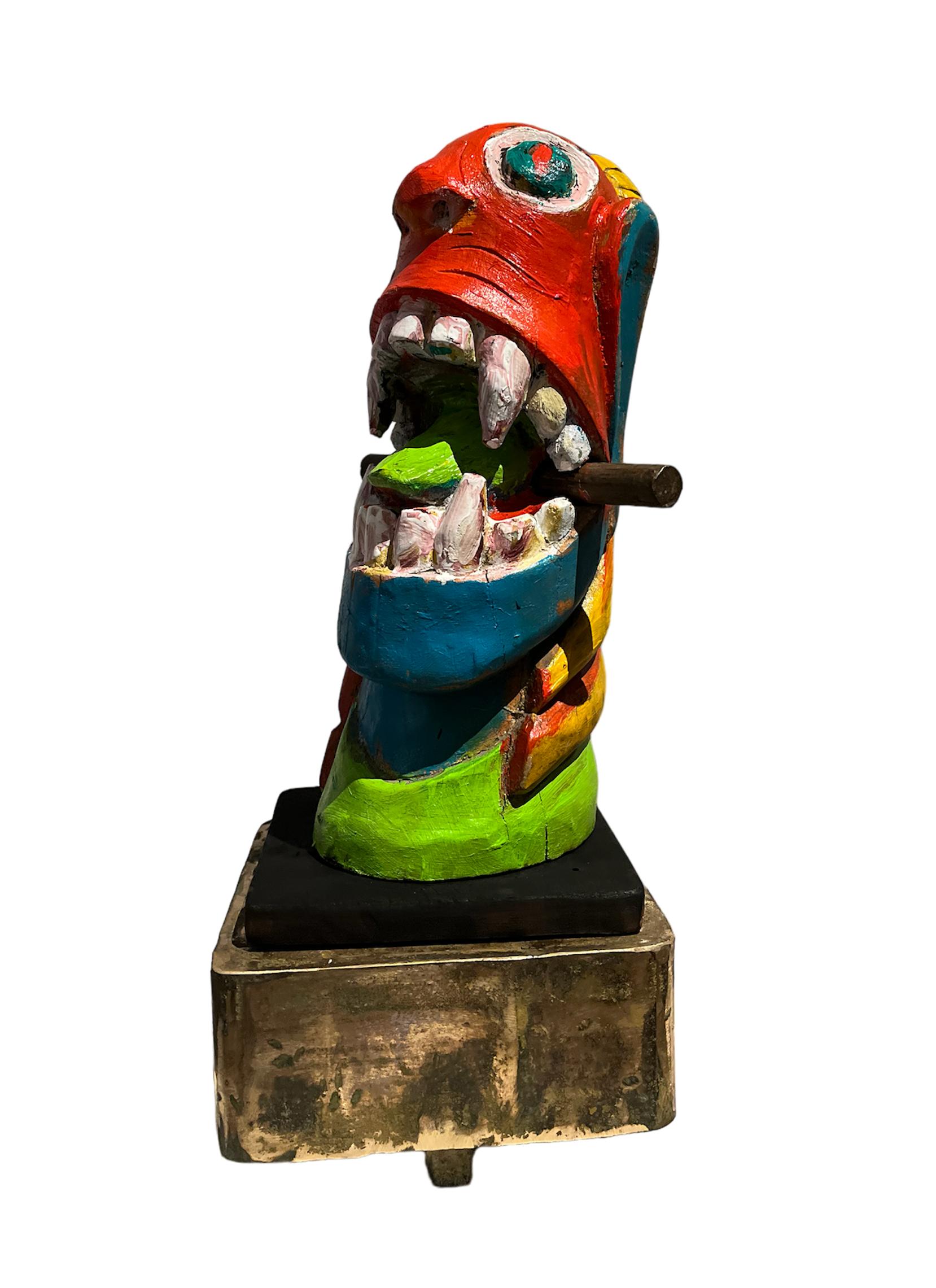Items Similar to "The Trap" Hayward Oubre, Painted Wire Sculpture, Black Artist
Want more images or videos?
Request additional images or videos from the seller
Hayward Oubre"The Trap" Hayward Oubre, Painted Wire Sculpture, Black Artistcirca 1960
circa 1960
About the Item
Hayward Oubre
The Trap, c. 1960
Painted wire sculpture
40 H. x 16 1/2 W. x 21 D. inches
Provenance:
Estate of the Artist
Deeply attached to his Southern heritage, Hayward Louis Oubre Jr. relied on childhood memories to create paintings and prints portraying African American life in his hometown of New Orleans. However, he is best remembered today for works that transcend any regionalist influences: airy wire sculptures that are celebrated for their resilience, strength, balance, and engineering mastery.
Born to a family of African and French descent, Oubre’s youthful artistic talent was encouraged in the New Orleans parochial schools he attended. Following high school, he enrolled at Dillard University, where he was a standout member of the football and track teams, an illustrator for the college newspaper, and the institution’s first art major. Upon his graduation in 1939, Oubre continued his studies at Atlanta University, thriving under the tutelage of painter and muralist Hale Woodruff and sculptor Nancy Elizabeth Prophet, who encouraged Oubre to submit his work to the annual Atlanta University exhibitions. In 1941, Oubre was assigned to help with a special art initiative at Tuskegee Institute, where he met George Washington Carver, an admirer of the fledgling artist’s work.
Oubre temporarily relinquished his artistic pursuits later in 1941 when he was drafted into military service. Serving with the Army Corps of Engineers during World War II, Oubre joined 3,700 African American soldiers charged with building a 1500-mile military supply route—now known as the Alcan Highway—that connected Alaska to the continental United States. These soldiers labored under brutal conditions to complete the assignment in eight months.
Thanks to the GI Bill, Oubre was able to continue his education in art at the University of Iowa, earning his master’s degree from the University of Iowa. He then launched an extended career as an art educator at a series of historically black colleges and universities: Florida Agricultural and Mechanical College for Negroes (1948‒1949); Alabama State College (1949‒1965); and, finally, at Winston-Salem State University (1965‒1981), where he initiated the studio art program. Over three decades, Oubre mentored countless aspiring African American artists and embraced an “open studio concept” which allowed pupils to advance at their own pace. In an effort to provide his painting students with the proper learning material, Oubre conceived and copyrighted “a concise study of color mixing and color relationships” using a color wheel that updated and expanded the 1810 color triangle developed by Johann Wolfgang von Goethe.
Oubre's two-dimensional works feature simplified, sometimes abstracted, forms that reflect the artist’s familiarity with Picasso’s Analytic and Synthetic Cubism. While he had previously employed clay and wood to create closed-form sculptures, it was during his tenure at Alabama State College in the 1950s that Oubre began fabricating his acclaimed wire sculptures. As he slowly and delicately shaped ordinary wire clothes hangers with hand pliers, the artist confronted structural challenges that demanded a considerable amount of strength and, at times, physical pain, to overcome. Nicknamed by his students as the “master of torque,” Oubre detailed his method in his 1960 publication, The Art of Wire Sculpture. One reviewer writing of Oubre’s sculptures opined that “light and air are as critical to the work as the metal that gives them definition.”
Although Oubre’s work was not widely exhibited during his lifetime, his oeuvre has attracted increased curatorial attention and examples of his work are represented in the collections of the Metropolitan Museum of Art, the Mint Museum of Art, and the University of Delaware. In 1993, the Pentagon honored Oubre and other surviving soldiers from the Alcan Highway battalion for their service.
- Creator:Hayward Oubre (1916 - 2006, American)
- Creation Year:circa 1960
- Dimensions:Height: 40 in (101.6 cm)Width: 16.5 in (41.91 cm)Depth: 21 in (53.34 cm)
- Medium:
- Period:
- Condition:
- Gallery Location:New York, NY
- Reference Number:1stDibs: LU1841212367642
About the Seller
5.0
Platinum Seller
These expertly vetted sellers are 1stDibs' most experienced sellers and are rated highest by our customers.
Established in 2021
1stDibs seller since 2022
62 sales on 1stDibs
Typical response time: 1 hour
- ShippingRetrieving quote...Ships From: New York, NY
- Return PolicyA return for this item may be initiated within 3 days of delivery.
More From This SellerView All
- "Hitch Hiked" Hayward Oubre, Painted Wire Sculpture, Southern Black ArtistLocated in New York, NYHayward Oubre Hitch Hiked, 1960 Signed on Base: OUBRE 60 Painted wire sculpture 45 H. x 21 W. x 19 D. inches Provenance: Estate of the Artist Deeply at...Category
1960s Figurative Sculptures
MaterialsWire
- "Tropical Parrot with Woman, " Corneille, Carved Wood Sculpture with BirdBy CorneilleLocated in New York, NYGuillaume Cornelis van Beverloo (Corneille) Tropical Parrot with Woman, circa 1970 Signed: Corneille Edition Number: 6 of 8 Constructed and Painted wood 39" high x 40 1/2" wide x 6" ...Category
1970s Figurative Sculptures
MaterialsWood, Paint
- "Abstract Sculpture, " Gerome Karmwoski, Wood Surrealist ExpressionismBy Gerome KamrowskiLocated in New York, NYGerome L. Kamrowski (1914 - 2004) Abstract Sculpture Oil on wood 62 inches high Provenance: The artist's estate Gerome Kamrowski was born in Warren, Minnesota, on January 19, 1914. In 1932 he enrolled in the Saint Paul School of Art (now Minnesota Museum of American Art - MMAA), where he studied with Leroy Turner, and Cameron Booth. Both Turner and Booth had been students of Hans Hofmann, and were also associated with the Abstraction-Création group in Paris. It was from these peers that Kamrowski was introduced to a "kind of expressionist cubism." In 1933 Kamrowski was awarded a scholarship to the Art Students League, where he would study in New York under Hans Hofmann. Unfortunately, immigration problems had prevented Hofmann from assuming his post. Nevertheless, Kamrowski decided to remain in New York for a short time, to attend classes taught by George Grosz. After a few weeks, he returned to St. Paul, and found a position in the mural painting division of the Minnesota FAP/WPA (Works Progress Administration). In 1936 he contributed “Synthetic Cubist Style” frescoes in the Northrup Auditorium of the University of Minnesota. In 1937 Kamrowski went to Chicago to study under László Moholy-Nagy and Alexander Archipenko at the New Bauhaus (now Illinois Institute of Technology's Institute of Design). There he was exposed to new and interesting ideas regarding the role of nature in art and the "geometric basis of natural form". In 1938 Kamrowski received a Guggenheim fellowship to attend Hans Hofmann's summer school in Provincetown, Massachusetts. He then relocated to New York where he met William Baziotes. Together they shared a fascination in Surrealist automatic writing, and both artists explored its possibilities in their paintings. Kamrowski was particularly drawn to Surrealism's fundamental appeal of intuition over intellect. He was interested seeking a process that "binds all things together...a kind of cosmic rhythm". Throughout the late 1930s and early 1940s while living in New York, Kamrowski became an integral part of the emerging surrealists. In 1942, the artist Roberto Matta attempted to form a group of artists to investigate new applications for Surrealist methods. He invited Kamrowski, along with William Baziotes, Jackson Pollock, Peter Busa...Category
1960s Post-War Abstract Sculptures
MaterialsWood, Oil
- Villa Adrienne #17By Georges NoelLocated in New York, NYGeorges Noel Villa Adrienne #17, 1976 Graphite, pigment, sand, and vinyl binder on canvas Signed to verso 76 3/4 x 51 inches The Pace Gallery label to versoCategory
1970s Assemblage Mixed Media
MaterialsCanvas, Vinyl, Graphite, Pigment
- "Untitled, " Seymour Fogel, Geometric Abstraction, Texas Hard-EdgeBy Seymour FogelLocated in New York, NYSeymour Fogel Untitled Oil on illustration board construction 10 x 7 1/2 inches Provenance: Estate of the artist Charles and Faith McCracken Larry and Trish Heichel Private Collection Seymour Fogel was born in New York City on August 24, 1911. He studied at the Art Students League and at the National Academy of Design under George Bridgeman and Leon Kroll. When his formal studies were concluded in the early 1930s he served as an assistant to Diego Rivera who was then at work on his controversial Rockefeller Center mural. It was from Rivera that he learned the art of mural painting. Fogel was awarded several mural commissions during the 1930s by both the Works Progress Administration (WPA) and the Treasury Section of Fine Arts, among them his earliest murals at the Abraham Lincoln High School in Brooklyn, New York in 1936, a mural in the WPA Building at the 1939-1940 New York World's Fair, a highly controversial mural at the U.S. Post Office in Safford, Arizona (due to his focus on Apache culture) in 1941 and two murals in what was then the Social Security Building in Washington, D.C., also in 1941. Fogel's artistic circle at this time included Phillip Guston, Ben Shahn, Franz Kline, Rockwell Kent and Willem de Kooning. In 1946 Fogel accepted a teaching position at the University of Texas at Austin and became one of the founding artists of the Texas Modernist Movement. At this time he began to devote himself solely to abstract, non-representational art and executed what many consider to be the very first abstract mural in the State of Texas at the American National Bank in Austin in 1953. He pioneered the use of Ethyl Silicate as a mural medium. Other murals and public works of art done during this time (the late 1940s and 1950s) include the Baptist Student Center at the University of Texas (1949), the Petroleum Club in Houston (1951) and the First Christian Church, also in Houston (1956), whose innovative use of stained glass panels incorporated into the mural won Fogel a Silver Medal from the Architectural League of New York in 1958. Fogel relocated to the Connecticut-New York area in 1959. He continued the Abstract Expressionism he had begun exploring in Texas, and began experimenting with various texturing media for his paintings, the most enduring of which was sand. In 1966 he was awarded a mural at the U.S. Federal Building in Fort Worth, Texas. The work, entitled "The Challenge of Space", was a milestone in his artistic career and ushered in what has been termed the Transcendental/Atavistic period of his art, a style he pursued up to his death in 1984. Painted and raw wood sculpture...Category
Mid-20th Century Abstract Geometric Abstract Paintings
MaterialsOil, Board
- "Roland, " George Sugarman, Abstract Steel SculptureBy George SugarmanLocated in New York, NYGeorge Sugarman (1912 - 1999) Roland, 1970 Patinated steel 17 3/8 x 16 x 5 1/4 inches Incised with the artist's signature and numbered "15/17" on the underside Manufactured by Lippin...Category
1970s Abstract Abstract Sculptures
MaterialsSteel
You May Also Like
- "Zāt Highchair II" Abstract Sculptural Chair 41" x 19" inch by Karim Abd ElmalakBy Karim Abd ElmalakLocated in Culver City, CA"Zāt Highchair II" Abstract Sculptural Chair 41" x 19" inch by Karim Abd Elmalak Medium: iron & oil-based spray paint Karim Abdel Malak's layered multi-media works are influenced b...Category
21st Century and Contemporary Contemporary Abstract Sculptures
MaterialsIron, Wire
- Orí Yucateca, Figurative Sculpture. From the Series SculpturesLocated in Miami Beach, FLOrí Yucateca, 2015 - 2024 by José Ignacio Suarez Solis From the Series Sculptures Carving, assembling and painting (granite, wood, iron, acrylic, zinc plate and copper wire) Size: 19...Category
2010s Abstract Abstract Sculptures
MaterialsGranite, Copper, Iron, Wire
- ORÍ GUERREIRA NA LUZ I, Figurative Sculpture. From the Series SculpturesLocated in Miami Beach, FLORÍ GUERREIRA NA LUZ I, 2021 - 2023 by José Ignacio Suarez Solis From the Series Sculptures Carving, assembling and painting (granite, wood, iron, acrylic, zinc plate and copper wire...Category
2010s Abstract Abstract Sculptures
MaterialsGranite, Copper, Iron, Wire
- ORÍ GUERREIRA NA LUZ II, Figurative Sculpture. From the Series SculpturesLocated in Miami Beach, FLORÍ GUERREIRA NA LUZ II, 2021 - 2023 by José Ignacio Suarez Solis From the Series Sculptures Carving, assembling and painting (granite, wood, iron, acrylic, zinc plate and copper wir...Category
2010s Abstract Abstract Sculptures
MaterialsGranite, Copper, Iron, Wire
- ORÍ GUERREIRA TUPINANDACARU I, Figurative Sculpture. From the Series SculpturesLocated in Miami Beach, FLORÍ GUERREIRA TUPINANDACARU I, 2018 - 2023 by José Ignacio Suarez Solis From the Series Sculptures Carving, assembling and painting (granite, wood, iron, acrylic, zinc plate and copp...Category
2010s Abstract Abstract Sculptures
MaterialsGranite, Copper, Iron, Wire
- Apropriaçao frei de carranca, Figurative Sculpture. From the Series SculpturesLocated in Miami Beach, FLApropriaçao frei de carranca, 2023 by José Ignacio Suarez Solis From the Series Sculptures Carving, assembling and painting (granite, wood, iron, acrylic, zinc plate and copper wire)...Category
2010s Abstract Figurative Sculptures
MaterialsGranite, Copper, Iron, Wire
Recently Viewed
View AllMore Ways To Browse
Vintage Analytical Balance
Military Vintage Clothes
Army Football
Military Clothes
Retro Wood Clothes Hanger
Vintage Wood Clothes Hanger
Vintage Wood Clothes Hangers
Metal Clothes Hangers
Aelle Manon
Amber Cowan
Boguslaw Popowicz
Cambodian Silver And Gold Buddha
Chieu Shuey Fook
Chola Bronze
Daniel Kafri
Darth Vador
Dinah Neill
Dodik Jegou
